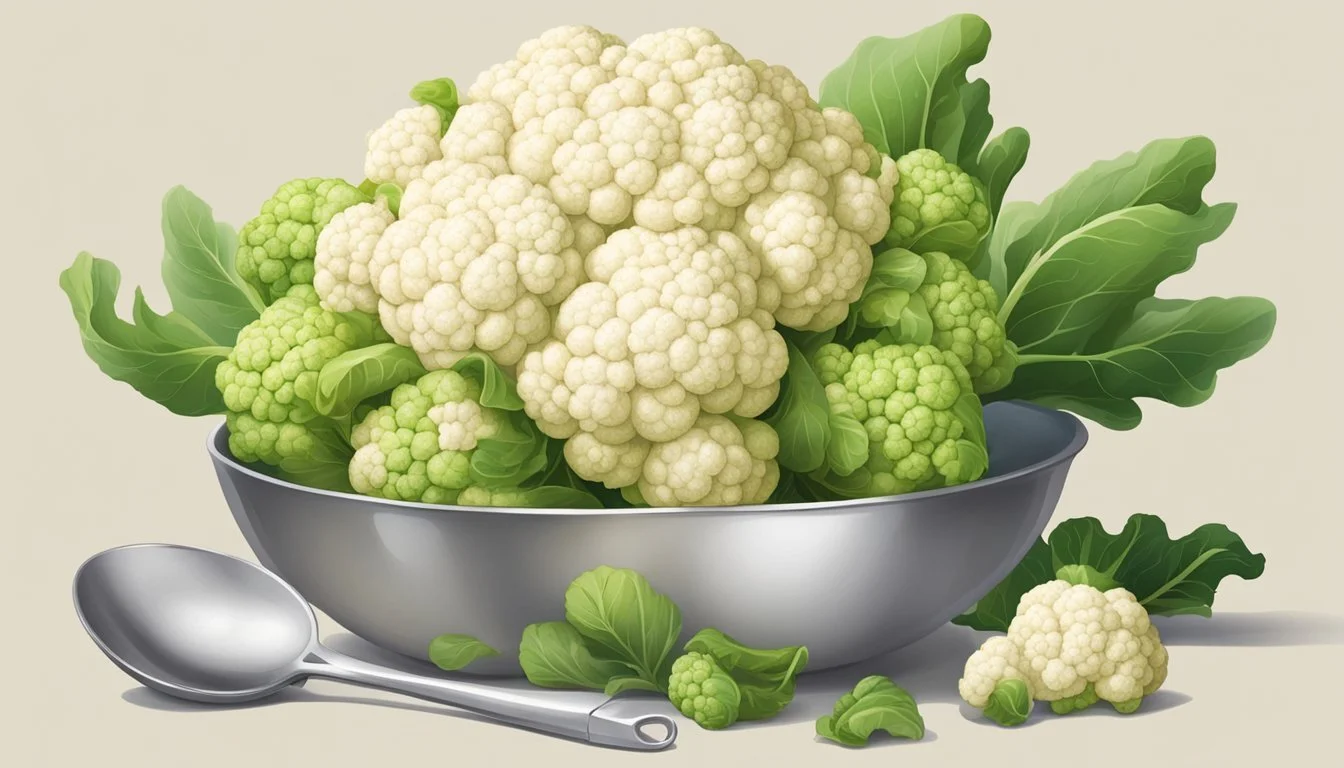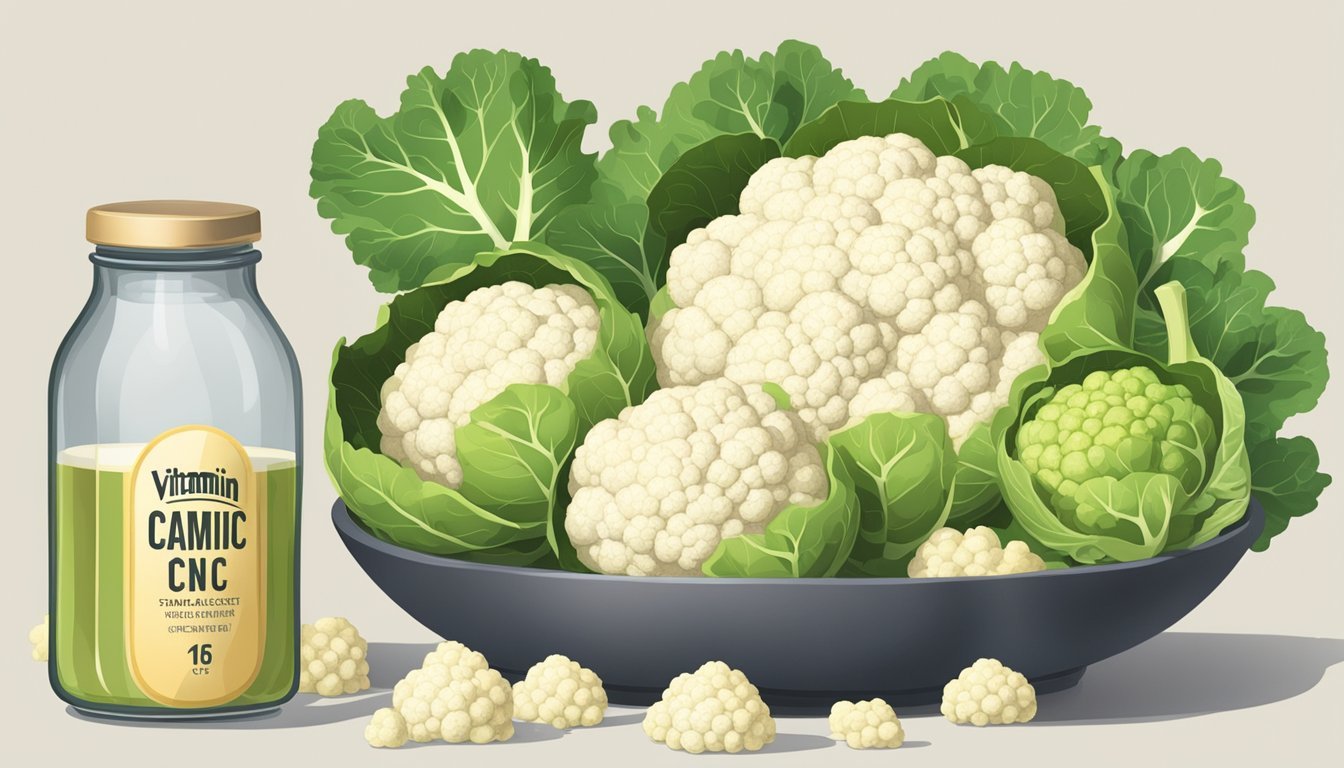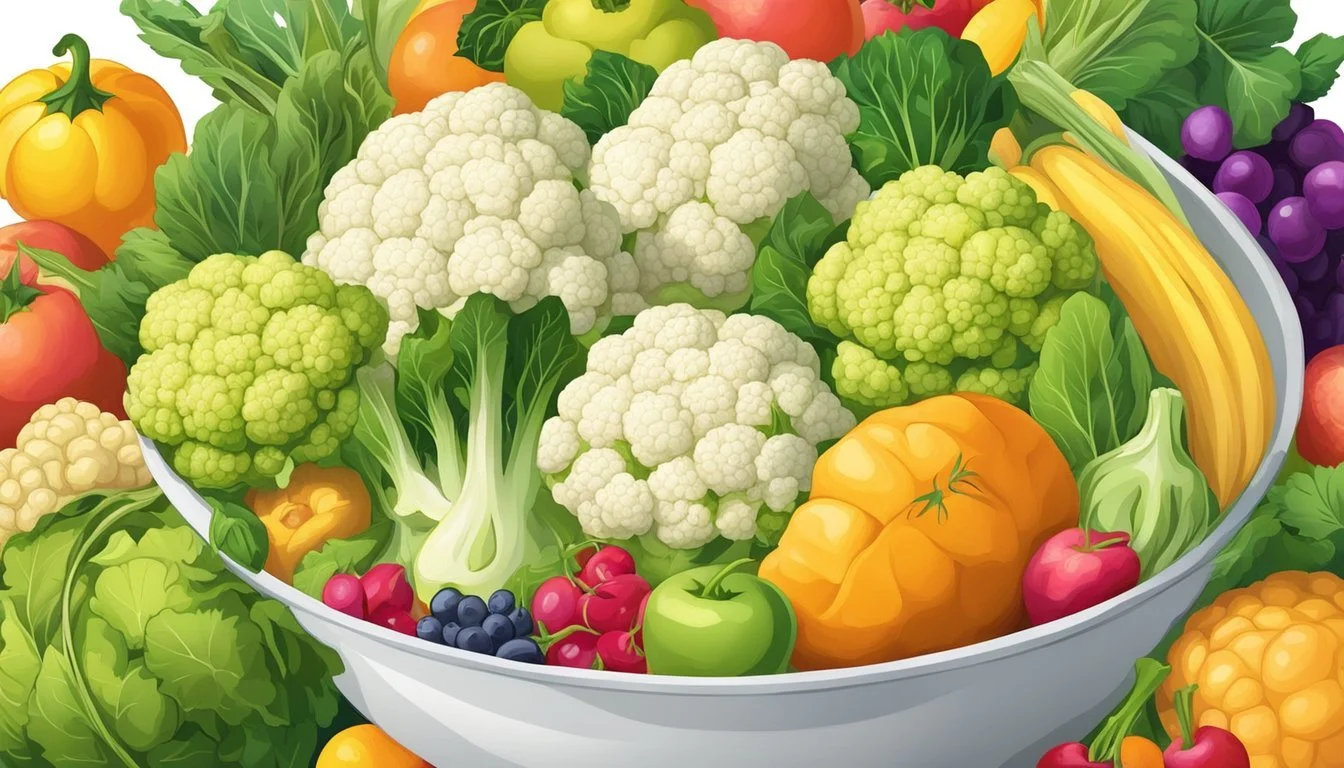How Many Cups of Cauliflower for Vitamin C Intake
Optimal Portions Explained
Cauliflower has emerged as a versatile and nutritious vegetable that is an integral part of many diets. It's low in calories but high in vitamins and minerals, especially vitamin C. One cup of cauliflower provides more than half of the daily recommended intake of this essential nutrient for adult women, which is 75 mg, and a significant portion for men, who require about 90 mg daily.
The benefits of vitamin C are significant; it's a powerful antioxidant that supports the immune system, aids in the absorption of iron, and promotes healthy skin and connective tissue. Regular consumption of cauliflower can help individuals meet their vitamin C requirements while also providing a boost in dietary fiber and other vital nutrients such as vitamin K and B6.
However, despite its health benefits, it's important to balance cauliflower intake with a variety of foods to avoid nutritional deficiencies and potential food sensitivities. Some individuals might experience gastrointestinal discomfort from excessive cauliflower consumption due to its fiber content and complex carbohydrates that can cause gas. Therefore, moderation is key to harnessing the nutritional value of cauliflower without encountering its less desirable effects.
Nutritional Profile of Cauliflower
Cauliflower is a low-calorie vegetable that is dense with various essential nutrients, crucial for maintaining overall health. It serves as a substantial source of vitamins and provides notable amounts of macronutrients.
Vitamins and Minerals
Cauliflower is renowned for its high Vitamin C content, with a single cup offering over 50 mg, contributing significantly to the daily recommended intake of 75 mg for adult women and 90 mg for men. In addition to Vitamin C, cauliflower contains other vital vitamins such as Vitamin K, essential for blood clotting and bone health, supplying around 16-20 micrograms per cup. The mineral content in cauliflower is noteworthy as well, providing:
Potassium: crucial for heart function and muscle contractions, approximately 300 mg per cup.
Magnesium: involved in over 300 biochemical reactions in the body, present in modest amounts.
Calcium, Choline, Folate, and Phosphorus: present in varying quantities that contribute to overall dietary needs.
Macronutrients
When it comes to macronutrients, cauliflower presents a balanced composition. Here's a quick overview:
Protein: Each cup contains about 2 grams, which is a good amount for a vegetable.
Fiber: With 2 grams per cup, it supports digestive health.
Carbohydrates: An average of 5 grams per cup, with part of these as naturally occurring sugars.
Fat: It is very low in fat, typically around 0.25 grams for a one-cup serving.
Cauliflower also has a negligible amount of sodium, making it a heart-healthy choice. Its macronutrient balance supports a range of dietary approaches, including those focused on weight management.
Health Benefits of Cauliflower
Cauliflower offers a multitude of health benefits primarily due to its rich nutrient profile, which includes a high content of vitamin C and other health-promoting compounds. These compounds contribute to its antioxidant effects, support heart health, and possess anti-inflammatory properties that can be advantageous for overall well-being.
Antioxidant Effects
Cauliflower is abundant in antioxidants, which help neutralize harmful free radicals. This action is crucial because free radicals can lead to oxidative stress, a contributor to various chronic diseases such as cancer and stroke. One of the primary antioxidants present in cauliflower is vitamin C. One cup of raw cauliflower can offer about 58% of the Daily Value (DV) for vitamin C, showcasing its powerful antioxidant capacity.
Heart Health
Regular consumption of cauliflower may be beneficial for heart health. As part of the cruciferous vegetables family, it contains compounds that have been linked with a lower risk of heart disease. The presence of fiber, for instance, aids in digestion and can help maintain healthy blood pressure levels, both of which are important factors in preventing heart conditions and stroke.
Anti-Inflammatory Properties
The anti-inflammatory properties of cauliflower stem from its various nutrients and antioxidants, which can help reduce inflammation in the body. Chronic inflammation is a known risk factor for several illnesses, including heart disease and cancer. Incorporating cauliflower into one's diet can contribute to lowering inflammation, thereby potentially reducing the risk of these and other inflammation-related conditions.
Cauliflower in the Diet
Cauliflower provides a versatile addition to a diet, especially for those seeking low-carb alternatives or aiming to increase vitamin C intake. It serves as an excellent ingredient across various cuisines and cooking methods.
Cauliflower as a Low-Carb Alternative
Cauliflower has become a popular substitute for high-carb foods, attributed to its low-calorie profile and nutritional benefits. Cauliflower rice is a common low-carb alternative to traditional rice, created by pulsing cauliflower florets in a food processor until they achieve a rice-like consistency. This alternative offers individuals managing diabetes or those on weight loss diets a way to enjoy their meals without the high carbohydrate content. Similarly, cauliflower crust pizza provides a lower-carb version of a beloved dish, aligning with low-carb dietary needs while still maintaining flavor.
Incorporation in Various Dishes
Cauliflower's adaptability makes it ideal for a range of recipes. Beyond being transformed into rice or crust for pizza, it can be included in pasta dishes as a substitute for traditional noodles, added to curries for its ability to absorb flavors, or pureed into a creamy cauliflower soup. Cooking methods such as steaming, boiling, and roasting can influence both the texture and the taste of cauliflower. Roasted cauliflower, for instance, is noteworthy for enhancing its natural sweetness and creating a caramelized exterior. Whether individuals are looking to innovate in the kitchen or maintain low-carb eating habits, cauliflower acts as a highly adaptable and nutritious option.
Portion Control and Serving Suggestions
When considering cauliflower as a source of vitamin C, it's important to understand the proper serving sizes that contribute effectively to a balanced diet.
Serving Sizes and Frequency
Cauliflower is a versatile cruciferous vegetable known for its numerous health benefits, including being a good source of dietary fiber and vitamin C. Recommended serving sizes specifically for cauliflower are not typically delineated in dietary guidelines as they are for some other foods. However, aiming for about 1 cup of raw cauliflower florets, which equates to approximately 25 calories, can be a useful guideline for portion control. This amount also delivers a nutrient-rich experience, as cauliflower is often considered a low-calorie superfood.
Most dietary recommendations suggest incorporating a variety of vegetables into one's diet daily, with an emphasis on variety for comprehensive nutrition. Therefore, while they may enjoy cauliflower regularly, individuals should rotate it with other vegetables to ensure a wide range of nutrients. Consuming a range of vegetables, including cauliflower, supports a healthy dietary pattern where one can reap multiple health benefits.
It's also worth noting that portion sizes can have an impact on caloric intake. Since cauliflower is a low-calorie vegetable, one can enjoy a larger volume without significantly increasing calorie consumption. This makes cauliflower an excellent choice for those who are monitoring their weight or looking to increase their vegetable intake without a substantial rise in calories.
Consumption Considerations
When incorporating cauliflower into one's diet for its vitamin C content, it is important to be mindful of potential digestive issues and adverse reactions. Portion sizes should be adjusted according to individual tolerance and health conditions.
Possible Digestive Issues
Cauliflower is high in fiber, which, although beneficial for digestive health, can lead to gas and discomfort in some individuals, especially those with Irritable Bowel Syndrome (IBS). Overconsumption may result in a gassy feeling and abdominal pain, so introducing cauliflower slowly and in moderate amounts is recommended.
Allergies and Interactions
While uncommon, allergies to cauliflower do exist and can cause symptoms such as itching and swelling. Additionally, cauliflower contains vitamin K, which can interact with thyroid medication and blood thinners. It is crucial for individuals on such medications to maintain a consistent intake to avoid complications.
Comparative Analysis with Other Vegetables
The cruciferous vegetable family, which includes cauliflower, broccoli, kale, (What wine goes well with kale?) and Brussels sprouts, offers a variety of health benefits. Specifically, this section examines the vitamin C content of cauliflower in comparison to other common cruciferous vegetables.
Cauliflower vs. Broccoli
Cauliflower and broccoli are close relatives with similar fiber content but differing vitamin profiles. A 1-cup serving of cauliflower contains approximately 53 mg of vitamin C, vital for immune function and skin health. In contrast, broccoli not only surpasses cauliflower with about 81 mg of vitamin C for the same serving size but also offers higher concentrations of vitamins A and K.
Cauliflower vs. Kale
Kale stands out in the cruciferous veggie family as a nutritional powerhouse. One cup of chopped raw kale provides 80 mg of vitamin C, overshadowing cauliflower's contribution. Kale's robust vitamin C content, coupled with its high fiber and antioxidant levels, make it a superior choice for those looking to maximize nutrient intake.
Cauliflower vs. Brussels Sprouts
Cauliflower and Brussels sprouts provide comparable amounts of vitamin C, with the sprouts containing slightly more at about 75 mg per cup. Although similar in vitamin C content, Brussels sprouts offer a denser nutrient profile, including increased amounts of fiber and a more pronounced taste that can complement a variety of dishes.
Preparing Cauliflower for Optimal Nutrient Retention
When preparing cauliflower, it's crucial to choose cooking methods that maintain its high vitamin C content while storing it properly to preserve its freshness and nutrients.
Cooking Methods
While cauliflower can be consumed raw, offering a full profile of its vitamins and minerals, the cooking process is often preferred for taste and digestibility. Steaming is one of the most effective methods to retain nutrients. When cauliflower is steamed, it comes into minimal contact with water, reducing the leaching of water-soluble nutrients like vitamin C, which cauliflower is rich in. Roasting can also be beneficial; cooking cauliflower at a moderate temperature of 400°F (around 204°C) for 20-25 minutes enhances flavor without significantly reducing nutrient content. Meanwhile, processes like boiling can result in substantial nutrient loss, as vitamins can leach into the boiling water.
Recommended methods for nutrient retention:
Steaming
Roasting
Less favorable method:
Boiling
Storage Tips
To maintain the nutrient quality of cauliflower, both fresh and frozen varieties should be stored correctly—affecting their vitamin C levels. Fresh cauliflower should be kept in the refrigerator, ideally in a crisp drawer that provides a consistent temperature and humidity level. If the cauliflower is pre-chopped, it should be stored in an airtight container and consumed within a few days to prevent nutrient degradation. Frozen cauliflower retains its vitamin C content well and should be kept frozen until ready to cook, ideally steamed directly from the freezer to prevent the thawing process from reducing nutrients.
Optimal storage for fresh cauliflower:
Refrigerator's crisp drawer
Airtight container for pre-chopped pieces
Optimal storage for frozen cauliflower:
Keep it frozen
Cook directly from freezer without thawing
The Role of Cauliflower in Disease Prevention
Cauliflower, a cruciferous vegetable, is a powerhouse of nutrition with a potent mix of vitamins, antioxidants, and phytochemicals that contribute to disease prevention. Its nutritional profile supports several aspects of health, particularly in preventing obesity, diabetes, and cancer.
Impact on Obesity and Diabetes
Cauliflower is a low-calorie vegetable, rich in fiber, which makes it an excellent food choice for those managing obesity and diabetes. The high fiber content aids in digestion and provides a sense of fullness, which helps to curb overeating. Additionally, the presence of glucosinolates in cauliflower may help maintain a healthy balance of insulin and glucose levels, reducing the risk of insulin resistance.
Nutritional Highlights Relevant to Obesity and Diabetes:
Calories: Low-calorie count supports a healthy weight management.
Fiber: High fiber content assists in appetite control and blood sugar regulation.
Cancer Prevention Strategies
As part of cancer prevention strategies, cauliflower contributes essential nutrients that protect cells from oxidative stress and DNA damage. It contains compounds like sulforaphane and other glucosinolates, which have been observed to have cancer-fighting properties. The high vitamin C content acts as an antioxidant, and regular consumption may help reduce the risk of various cancers.
Key Nutrients for Cancer Prevention:
Antioxidants: Neutralize harmful free radicals and protect against cellular damage.
Sulforaphane: Promotes detoxification and may inhibit cancer cell growth.
Cauliflower Substitutes in Cooking
In the pursuit of culinary variety or dietary requirements, one may seek alternatives to cauliflower, especially when its role is to fortify meals with essential nutrients. This section investigates tried and trusted substitutes that align with specific dietary needs, transitioning smoothly into established recipes like cauliflower rice, flour-based dishes, and gluten-free options.
Alternatives for Specific Dietary Needs
The following substitutions cater to various dietary restrictions while aiming to mimic cauliflower's versatility in recipes:
Grains and Rice Alternatives: For those incorporating more grains or seeking a rice-like texture, cabbage can be finely shredded to resemble cauliflower rice. It offers a comparable consistency with a subtle, sweet undertone.
Non-starchy Options: To reduce intake of starchy vegetables and maintain a low carbohydrate diet, one might opt for mushrooms. Their savory flavor and firm texture lend themselves well to dishes like pizza crusts, while keeping sugars in check.
Flour and Gluten-free Requirements: For a gluten-free flour alternative, one can consider using legume flour. It provides nutritional benefits similar to mashed cauliflower and can replace traditional flour in recipes for pasta and pizza crust, ensuring a gluten-free meal.
Vegetable Substitutions: Vegetables such as broccoli, zucchini, and asparagus share textural similarities with cauliflower, making them excellent for an assortment of dishes, from baked goods to stir-fries to creamy soups. Broccoli particularly stands out for its close flavor profile to cauliflower.
Environmental and Economic Aspects of Cauliflower Production
Cauliflower production involves both environmental and economic considerations that are essential for sustainable agriculture. Through understanding the interplay between these factors, one can appreciate the complexities of farming methods that contribute to the viability of cauliflower as a crop.
Sustainability Factors
Sustainability in cauliflower production hinges on multiple elements. Addressing environmental impact requires careful management of resources such as water and energy, especially during irrigation. The use of pesticides is another critical area where mitigation efforts can reduce carbon footprints. Making these processes more efficient and less harmfully affects sustainability.
Economic aspects of cauliflower production are significant economic considerations for growers. From the market value of the produce — which stood at $346.391 million in utilized production in 2020 — to the fluctuations in fresh cauliflower imports, various factors influence the profitability of cauliflower farming. There is a noticeable impact on the industry's economy from external events, as seen with projections showing a 10 percent decline in imports due to a global pandemic in 2020.
Farmers aim to strike a balance between environmentally friendly farming methods and economically viable practices. This balance is crucial for the long-term sustainability of the cauliflower industry. It is important to consider that a shift towards more sustainable agricultural practices might involve initial costs but can lead to better environmental outcomes and potential long-term economic benefits through efficiency and improved product quality.
Gastrointestinal Effects of Cauliflower Consumption
When including cauliflower in their diet, individuals may experience various gastrointestinal effects due to the vegetable's fiber content. Specifically, cauliflower contains insoluble fiber which impacts bowel movements and can cause gas for some people.
Managing Gassiness and IBS
Cauliflower contains insoluble fiber which is beneficial for digestive health as it adds bulk to stool, aiding regularity. However, for individuals with Irritable Bowel Syndrome (IBS) or those sensitive to diet-induced gas, this same fiber can become a source of discomfort. Gassiness can result from the fermentation of the fiber by bacteria in the large intestine.
To reduce potential gassiness:
Introduce cauliflower into the diet gradually.
Ensure adequate hydration to help the fiber move through the digestive system.
Combine with soluble fiber-rich foods to balance digestion.
It's vital for individuals with IBS to approach cauliflower consumption with caution, as it may trigger symptoms. They should consult a healthcare provider for a tailored dietary approach. Remember, the health benefits of cauliflower including its role in potentially reducing the risk of chronic diseases, make it a valuable food choice when consumed within personal tolerance levels and with mindful preparation.
Myths and Misconceptions about Cauliflower
It is essential to discern fact from fiction when considering the health benefits and nutritional value of cauliflower.
Common Misbeliefs
Cauliflower as a Superfood: Although cauliflower is nutritious, labeling it a superfood oversimplifies its value. Superfoods are not a scientific classification but a marketing term. Cauliflower is high in vitamins and minerals but should be part of a diverse diet.
Myth: Cauliflower is devoid of any nutritional value.
Fact: Cauliflower is rich in vitamin C, vitamin K, and fiber.
Misconception: Eating cauliflower can replace all other vegetables.
Fact: A variety of vegetables is necessary for a well-rounded nutrient intake.
Nutritional Myths:
Myth: Cauliflower causes constipation and thus should be avoided.
Fact: Cauliflower is high in dietary fiber, which generally aids in digestion and regular bowel movements.
Dietary Misconceptions:
Misconception: More cauliflower equals better health.
Fact: Balance is key. Overconsumption of any food, regardless of its health benefits, can lead to digestive issues or nutrient imbalances.
By understanding these common misconceptions, individuals can appreciate cauliflower's place within a balanced diet without overstating its benefits.
Varieties of Cauliflower and Their Characteristics
Cauliflower, a member of the cruciferous vegetables family, is esteemed not only for its health benefits but also for its variety, each differing in color and taste. These characteristics make each variety distinct and suitable for various culinary applications.
Color and Taste Variations
Cauliflower comes in a spectrum of colors beyond the common white variety. The color of the cauliflower is indicative of its nutrient profile and can add a vibrant touch to dishes.
White Cauliflower: The classic variety, known for its mild and slightly sweet taste. It's versatile in the kitchen and can even be used as a low-carb substitute for white rice in certain recipes.
Green Cauliflower (Vitaverde): This green hybrid is known for growing well in both warm and cool weather and offers a similar taste to the traditional white variety.
Purple Cauliflower: Offers a more earthy and nutty flavor. The vibrant purple hue is due to the presence of the antioxidant anthocyanin, which may offer additional health benefits.
Romanesco: With its striking green, spiky appearance, Romanesco provides a more intense flavor than white cauliflower and has a slightly crunchy texture.
Each variety not only adds a visual appeal to meals but also varies slightly in taste, providing an array of options for those looking to include more fruits and vegetables in their diet. When considering their characteristic taste profiles, one can creatively incorporate them into recipes, benefiting from the rich nutrients and flavors they offer.
Cauliflower in Cultural Cuisines
Cauliflower boasts a versatility that has embedded it deeply in the culinary traditions of various cultures worldwide. It transcends borders, making its mark in a myriad of traditional dishes.
Global Use in Traditional Dishes
In India, cauliflower is a staple in numerous regional cuisines and takes center stage in dishes like Aloo Gobi—a hearty mix of potatoes (aloo) and cauliflower (gobi) seasoned with a spice blend that often includes turmeric, cumin, and coriander.
Moving to the Middle East, cauliflower proves its adaptability in Arabic kitchens, featuring in Mezze platters as pickled or fried florets often accompanied by tahini sauce. Another popular dish is Shawarma spiced roast cauliflower, utilizing the traditional Shawarma seasoning to create a flavorful vegetarian option.
Italy celebrates cauliflower in Sicilian cuisine, where it’s an integral part of Pasta con i cavolfiori, a dish combining cauliflower with raisins, pine nuts, saffron, and pasta.
In the United States, the versatility of cauliflower is conspicuous in the recent health-conscious trends, where it serves as a low-carb substitute in recipes like cauliflower rice and cauliflower pizza crust.
Meanwhile, in France, cauliflower is often savored in a traditional dish called Chou-fleur à la béchamel, where it's smothered in a creamy béchamel sauce.
Each culture incorporates cauliflower not just for its nutritional value but also for the unique textures and flavors it lends to their culinary art, demonstrating the cultural significance and global appreciation for this vegetable in traditional cuisines.















